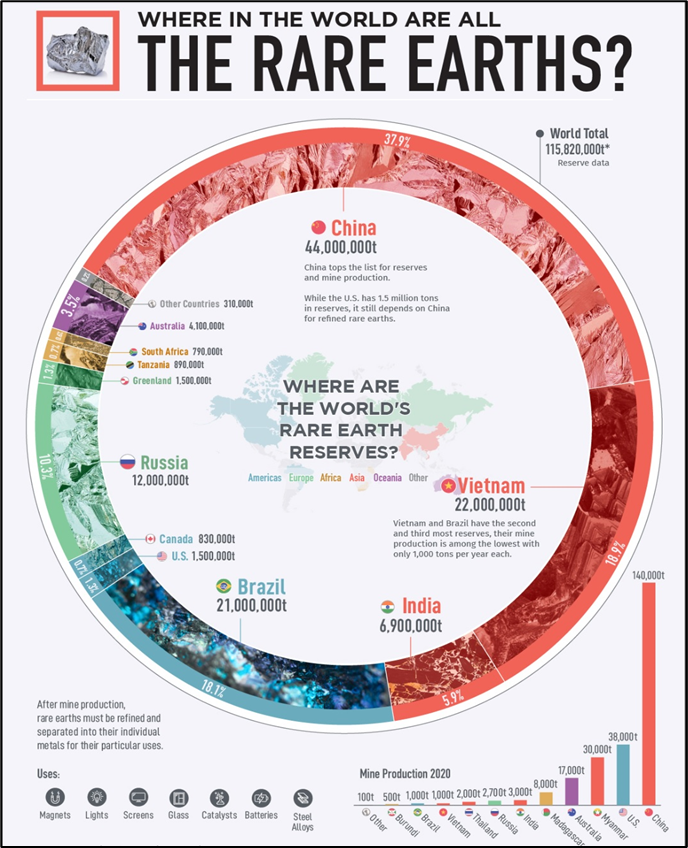Why in news?
- Swedish state-owned mining company, LKAB, announced that it has discovered more than one million tonnes of rare earth oxides in the northern area of the country.
What’s in today’s article:
- Rare earths elements (REEs) – About, uses, importance, distribution, REEs & India
- News Summary
Rare Earths Elements
- REEs or rare earth metals are a set of 17 chemical elements in the periodic table — the 15 lanthanides, plus scandium and yttrium.
- REEs are classified as light RE elements (LREE) and heavy RE elements (HREE).
- These metals tend to occur in the same ore deposits as the lanthanides, and have similar chemical properties.
- The 17 rare earths are:
- cerium (Ce), dysprosium (Dy), erbium (Er), europium (Eu), gadolinium (Gd), holmium (Ho), lanthanum (La), lutetium (Lu), neodymium (Nd), praseodymium (Pr), promethium (Pm), samarium (Sm), scandium (Sc), terbium (Tb), thulium (Tm), ytterbium (Yb), and yttrium (Y).
Uses
- These elements are important in technologies of consumer electronics, computers and networks, communications, clean energy, advanced transportation, healthcare, environmental mitigation, and national defence, among others.
- Scandium is used in televisions and fluorescent lamps, and yttrium is used in drugs to treat rheumatoid arthritis and cancer.
- Rare earth elements are used in space shuttle components, jet engine turbines, and drones.
- Eg., Cerium is essential to NASA’s Space Shuttle Programme.
Why rare earths have become even more important in recent years?
- In recent years, there has been an increase in demand for green energy.
- Hence the demand for elements like neodymium and dysprosium, which are used in wind turbine motors, has increased.
- Also, the push for switching from internal combustion cars to electric vehicles has also led to a rise in demand for rare earth magnets — made from neodymium, boron, and iron — and batteries.
Rare Earths Elements: Distribution and production

India and Rare Earth (RE) Metals
- India has 6% of the world’s rare earth reserves but it produces 1% of global output.
- Some REE are available in India such as Lanthanum, Cerium, Neodymium, Praseodymium and Samarium.
- Others such as Dysprosium, Terbium, Europium that are classified as HREE are not available in Indian deposits in extractable quantity.
- Hence, there is a dependence on countries such as China for HREE, which is one of the leading producers of RE with an estimated 70 per cent of the global production.
- Indian Rare Earths Ltd has been engaged in the mining and beneficiation of the heavy minerals.
- As per the Foreign Trade Policy, 2015-2020, the import of ores and concentrates of rare earth metals and of rare earth oxides including rutile sand are permitted freely.
News Summary
- Sweden’s state-owned mining company has identified more than 1 million tonnes of rare earth minerals in the northern area of Kiruna.
- The deposit, found next to its iron ore mine, was the largest of rare earth oxides in Europe.
What does the discovery mean for Europe and the world?
- Relief to western countries
- Against the backdrop of the fraught relations between China and other western countries, the new discovery has come as a relief.
- Breaking Chinese monopoly
- Globally, China holds a monopoly over rare earths production, following the withdrawal of USA from this business due to environmental and health issues.
- China has repeatedly used its monopoly in the rare earths market for furthering its geopolitical agendas.
- In 2010, Beijing blocked Japan’s access to rare earth elements over Tokyo’s detention of a Chinese fishing trawler captain.
- Boost to Minerals Security Partnership (MSP)
- The present discovery in Sweden will further strengthen the agenda of Minerals Security Partnership (MSP).
- In August 2022, US and 10 other Partners came together for this alliance known as MSP.
- Partners include Canada, Australia, Finland, Germany, France, Japan, Republic of Korea, Sweden, UK, US, and European Commission.
- The goal of the MSP is to ensure that critical minerals are produced, processed, and recycled in a manner that supports the ability of countries to realize the full economic development benefit of their geological endowments.
- The alliance was seen as primarily focused on evolving an alternative to China.









